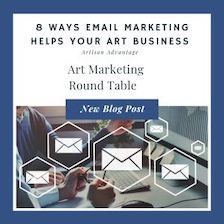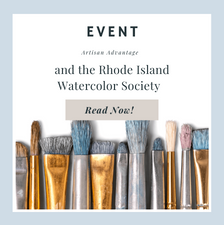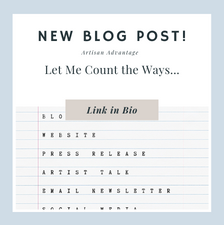Artisan Advantage Blog
Mastering the Art of Blogging: Join an Art Marketing Roundtable!
Blogging for Your Art Business Having a solid online presence for your art business is crucial for success. One powerful tool that can significantly enhance your art marketing strategy is blogging. Whether you're a painter, sculptor, photographer, or any other...
Crafting a One-Page Business Plan for Your Art Business
Write A One-Page Business Plan for Your Art Business Recently I was asked if I had a business planning template that I could offer to an artist. While I've attempted to create them over the years, the truth is that when I work with an artist on planning, I typically...
Do You Need a Blog AND an Email Newsletter for Your Art Business?
Let's Talk about Blogging and Email Newsletters Email marketing was one of the topics covered recently in an Artisan Advantage Art Marketing Roundtable was email marketing. Coming up in August, we will be talking about blogging for an art business. Artists have...
The Role of a Well-Designed Plan for Your Art Business
Do you have a business plan for your art business? It might not be that unusual that you don't. If you started selling your art as a side business and fell into it, as sometimes happens, you may not have one. Or, maybe you've been so busy working between producing...
Art Marketing Round Table: Do a Mid-Year Review of Your Art Business
How’s Your Year Going? Do you plan once for your year and then not look at it again for the rest of the year? If you do, you're not alone. It's not uncommon to make solid plans and then get so busy with your work that you don't check back in to assess how things are...
Building an Email List for Your Art Business
Email List Building For Artists As an artist, cultivating a strong connection with your audience is essential for growing your business. One powerful tool that can help you achieve this is using email marketing. Sending email campaigns allows you to engage with your...
How to Choose an Email Service to Market Your Art
Promote Your Art Business with Email Marketing Email marketing has become an important for businesses, including art businesses. Sending targeted, well-designed emails to your customers and subscribers can help you build relationships, promote your artwork, and boost...
Art Marketing Round Table: Selling Art Online
Selling Art Online: From your website to popular e-commerce platforms. There are a lot of choices when it comes to selling art online. Online marketplaces like Etsy allow you to sell direct consumers without using your website. Online galleries such as U-Gallery will...
Eight Reasons Email Marketing is Good for Your Art Business
Are you using email marketing for your art business? Email marketing has been around for a long time, so it might get overlooked in your marketing plan in the face of new shiny marketing platforms. Or, maybe you used it once but dropped it as you got busier with other...
Getting PR and Publicity for Your Art Business
Public relations (PR) and publicity can play a crucial role in the success of your art career. In today's competitive art world, standing out among the sea of many talented artists is essential. PR and publicity can help you build your reputation, increase your...
Foundations of an Art Marketing System – Online Class with the Rhode Island Watercolor Society
Join Artisan Advantage and the Rhode Island Watercolor Society for a comprehensive class teaching you how to set up a marketing system for your art business.
Let Me Count The Ways….
All the Ways You Write about Your Art Have you considered all the ways that you could potentially need to write about your art? While preparing for my upcoming Art Marketing Round Table, I thought about all the different ways an artist might need to write about...
Join My Newsletter!
Get a weekly update with art marketing tips, news about upcoming events and more!











